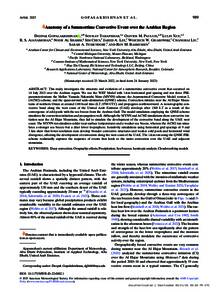Document
Anatomy of a summertime convective event over the Arabian Region.
Contributors
Taraphdar, Sourav., Author
Pauluis, Olivier M., Author
Xue, Lulin., Author
Ajayamohan, R. S., Author
Al-Shamsiyah, Noor., Author
Chen, Sisi., Author
Lee, Jared A., Author
Grabowski, Wojciech W., Author
Tessendorf, Sara A., Author
Rasmussen, Roy M., Author
Publisher
Monthly Weather Review.
Gregorian
2023-04
Language
English
Subject
English abstract
This study investigates the structure and evolution of a summertime convective event that occurred on
14 July 2015 over the Arabian region. We use the WRF Model with 1-km horizontal grid spacing and test three PBL
parameterizations: the Mellor–Yamada–Nakanishi–Niino (MYNN) scheme; the Asymmetrical Convective Model, version 2,
(ACM2) scheme; and the quasi-normal scale-elimination (QNSE) scheme. Convection initiates near the Al Hajar Moun tains of northern Oman at around 1100 local time (LT; 0700 UTC) and propagates northwestward. A nonorographic con vective band along the west coast of the United Arab Emirates (UAE) develops after 1500 LT as a result of the
convergence of cold pools with the sea breeze from the Arabian Gulf. The model simulation employing the QNSE scheme
simulates the convection initiation and propagation well. Although the MYNN and ACM2 simulations show convective ini tiation near the Al Hajar Mountains, they fail to simulate the development of the convective band along the UAE west
coast. The MYNN run simulates colder near-surface temperatures and a weaker sea breeze, whereas the ACM2 run simu lates a stronger sea breeze but a drier lower troposphere. Sensitivity simulations using horizontal grid spacings of 9 and
3 km show that lower-resolution runs develop broader convective structures and weaker cold pools and horizontal wind
divergence, affecting the development of convection along the west coast of the UAE. The 1-km run using the QNSE PBL
scheme realistically captures the sequence of events that leads to the moist convection over the UAE and adjacent
mountains.
Member of
Category
Journal articles

